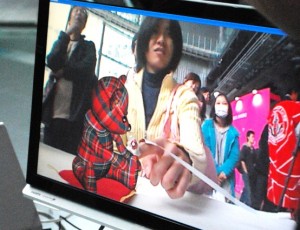Haptic Ring Lets You Feel Objects in Augmented Reality (Video)
Share

A vibrating ring allows you to feel like you are touching a virtual teddy bear.
The first thing that we often give children to hold is a stuffed animal so it makes sense that the first virtual object that you touch will be a teddy bear. At the Digital Contents Expo in Tokyo, developers demonstrated a ring that uses vibrations to let you feel what you see on a screen. This augmented reality touchy-feely experience is the brainchild of Tokyo Institute of Technology and the University of Electro-communications. The cute and cuddly teddy bear the ring lets you interact with is known as a Virtual Creature (VC) and is as much of the focus of the research as the ring itself. Check out the videos after the break.
When we talk about haptics, the transfer of sensation from the digital world to the real world, we often discuss the next generation of human-computer interfaces. Future hardware and software could become more intuitive when you can actually feel what you are working with. However, haptics are also a key point of entry into full sensory virtual reality. Augmented reality, with its blend of digital and real-world images, is a sort of VR-lite and it's a good testing ground for a haptics device. While not nearly complex enough to give you the sensation of being immersed in a virtual environment, the haptics ring is a good first step into that realm.
Skip ahead to 0:42 to see the haptics ring.
Be Part of the Future
Sign up to receive top stories about groundbreaking technologies and visionary thinkers from SingularityHub.


The developers of the ring actually debuted it a little earlier in the year with a poster at SIGGRAPH. Virtual Creatures which interact with the device can be moved by the users pushes and respond to the type of contact. With light petting, the VC will display happy emotions. A strong push will cause the VC to avoid or react negatively to the user. This complex behavior for the VC gives an added layer of realism to the augmented reality interaction. After all, what use is having a finger that can manipulate a virtual world if the virtual world doesn't react appropriately.
Of course, this ring isn't the first such haptics system. There have been many finger-based devices, most of which use vibrations to transfer the sense of touch. Without a way to restrict finger movement, these systems cannot translate the full range of tactile sensations and users must still rely on visual cues to let them know the appropriate range of their motion. By focusing on creating realistic virtual creatures, the Tokyo team has helped enhance that visual cuing so that it feels more natural.
Human muscle control is a remarkable thing. Give your fingers the right stimulation and you can train them to recoil even if they don't meet harsh resistance. This is partly how you can type on a keyboard lightly without pressing the keys all the way down. I'm confident that with enough practice and with some good visual guides, you or I could use haptics rings to interact with virtual objects successfully. We'd train ourselves to stop our fingers when we feel the ring's vibrations. As such, the haptics ring is a simple and viable gateway into feeling VR (or AR) environments. Eventually though, we will want a haptics system that can completely immerse us in the physicality of a virtual world. When that happens, the boundaries between the real and digital will seem less important to the casual observer. Who knows, maybe humans will start to prefer the artificial reality. If that scares you, don't worry, we have a teddy bear you can hold.
Photo credit: CNET
Video credit: Gregoirecliquet, IDG News Service, Network.World.TV
Related Articles

How Scientists Are Growing Computers From Human Brain Cells—and Why They Want to Keep Doing It

These Brain Implants Are Smaller Than Cells and Can Be Injected Into Veins

This Wireless Brain Implant Is Smaller Than a Grain of Salt
What we’re reading